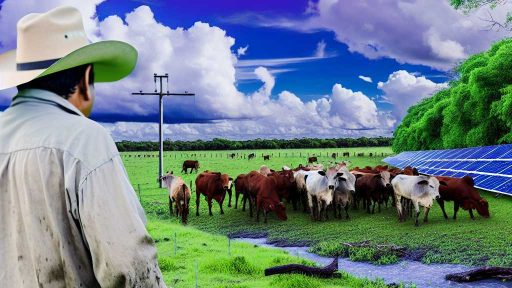Understanding Permaculture Principles and Ethics for Food Forests
Key Principles of Permaculture
Permaculture emphasizes working with nature, not against it.
This approach fosters healthy ecosystems and sustainable practices.
Additionally, permaculture promotes diversity in plant selection.
Using native plants boosts resilience and reduces maintenance.
Soil health is paramount in permaculture design.
Practices like mulching and composting enrich the soil.
Water management is also a crucial component of permaculture.
Implementing swales and rain gardens enhances water retention.
Finally, permaculture encourages energy efficiency.
Using renewable energy sources minimizes environmental impact.
Ethics of Permaculture
Three core ethics underpin permaculture: care for the earth, care for people, and setting limits to consumption.
Care for the earth involves preserving natural ecosystems.
This means protecting biodiversity and restoring degraded environments.
Care for people focuses on human well-being and community support.
Creating sustainable food systems fosters self-reliance and sharing.
Transform Your Agribusiness
Unlock your farm's potential with expert advice tailored to your needs. Get actionable steps that drive real results.
Get StartedSetting limits to consumption ensures equitable resource distribution.
This promotes responsible stewardship of resources for future generations.
Benefits of Applying Permaculture in Food Forests
Integrating permaculture into food forests yields numerous benefits.
First, it enhances biodiversity, attracting beneficial insects and wildlife.
Next, it promotes healthy soil through natural amendments.
Also, permaculture designs are self-sustaining and reduce work over time.
Furthermore, food forests provide a space for community engagement.
These areas can serve as educational platforms for sustainable practices.
Ultimately, permaculture fosters a closer relationship with nature.
Engaging with the ecosystem cultivates a sense of belonging and responsibility.
Choosing the Right Location
Importance of Site Assessment
Conducting a site assessment helps determine the suitability of your location.
A well-chosen site enhances your food forest’s resilience and productivity.
Moreover, it allows you to utilize natural resources effectively.
Evaluating Soil Conditions
Begin by testing the soil composition and quality.
Look for soil pH, texture, and nutrient content.
Healthy soil promotes robust plant growth.
Additionally, assess drainage and water retention capabilities.
Analyzing Sunlight Exposure
Next, observe how much sunlight your chosen area receives.
Different plants require varying sunlight levels.
Position your food forest to maximize sunlight capture.
Consider the seasonal changes in sunlight patterns.
Assessing Water Sources
Examine existing water resources in and around your site.
Identify nearby rivers, streams, or ponds.
Also, consider rainfall patterns and water retention.
Showcase Your Farming Business
Publish your professional farming services profile on our blog for a one-time fee of $200 and reach a dedicated audience of farmers and agribusiness owners.
Publish Your ProfileEffective water management is crucial for plant health.
Evaluating Microclimates
Recognize that microclimates can affect plant growth significantly.
Look for areas that may be warmer or cooler than the general climate.
Variations in wind patterns and humidity levels are also important.
Considering Surrounding Ecosystems
Review the neighboring ecosystems to understand their impact.
Healthy biodiversity can enhance your food forest.
Additionally, learn which pests and wildlife might be present.
Defining Accessibility
Ensure your selected site is accessible for maintenance and harvesting.
Roads, paths, and entry points play a significant role in management.
Plan for easy access to both tools and produce.
Selecting Companion Plants: Diversity and Layers in Food Forest Design
The Importance of Companion Planting
Companion planting enhances biodiversity in a food forest.
It creates a symbiotic relationship between plants.
This relationship boosts growth and health across species.
Furthermore, it can help deter pests naturally.
Overall, it promotes a more resilient system.
Understanding Plant Layers
A food forest is structured in layers.
These layers include canopy, understory, shrubs, and ground cover.
Each layer serves a unique purpose.
This design maximizes space and resources.
It also mimics natural ecosystems effectively.
Choosing Companion Plants
Selecting the right companion plants is crucial.
Consider plants that support one another’s growth.
Herbs, flowers, and vegetables can thrive together.
For example, basil benefits tomato plants significantly.
This relationship enhances flavors and deters pests.
Diversity Through Polycultures
Polyculture refers to growing multiple plant species together.
This practice reduces the risk of crop failure.
It provides habitat for beneficial insects.
Moreover, it enriches the soil and ecosystem.
Ideal combinations improve yields and resilience.
Examples of Effective Companion Plants
- Squash, corn, and beans form the Three Sisters.
- Nasturtiums repel aphids and attract pollinators.
- Comfrey aids nutrient cycling and supports larger plants.
- Garlic can deter many pests while aiding neighboring plants.
Practical Tips for Implementation
Start with a site assessment before planting.
Determine which plants thrive in your area.
Observe sunlight patterns and soil types carefully.
Next, select plants based on their growth needs.
Lastly, experiment and adjust your combinations over time.
Gain More Insights: The Impact of Precision Agriculture on Soil Erosion and Conservation
Soil Health Techniques for Building Fertile Soil in Food Forests
Understanding Soil Health
Ssoil health is crucial for successful food forests.
It affects plant growth and ecosystem vitality.
Healthy soil promotes biodiversity and enhances resilience.
Utilizing Composting
Composting enriches soil with organic matter.
Showcase Your Farming Business
Publish your professional farming services profile on our blog for a one-time fee of $200 and reach a dedicated audience of farmers and agribusiness owners.
Publish Your ProfileIt enhances soil structure and nutrient content.
Start by collecting kitchen scraps and yard waste.
Mix green materials with brown materials for balance.
Turn the compost regularly to aerate it.
Implementing Mulching Practices
Mulching retains moisture and suppresses weeds.
Organic mulch improves soil fertility as it decomposes.
Use materials like leaves, straw, or wood chips.
Apply a thick layer to maximize benefits.
Practicing Crop Rotation
Crop rotation prevents nutrient depletion in the soil.
Different plants have varied nutrient needs.
Rotate plants to maintain soil balance.
This practice also disrupts pest and disease cycles.
Integrating Cover Crops
Cover crops enhance soil structure during off-seasons.
They prevent erosion and improve soil fertility.
Plant legumes to fix nitrogen in the soil.
Clover and vetch are excellent options for cover crops.
Enhancing Soil with Biochar
Biochar improves soil moisture retention and fertility.
It also aids in sequestering carbon in the soil.
Incorporate biochar into the soil before planting.
This method promotes beneficial microbial activity.
Encouraging Earthworm Activity
Earthworms enhance soil aeration and nutrient cycling.
They break down organic matter into available nutrients.
Provide organic material to attract and maintain earthworm populations.
A healthy earthworm population indicates fertile soil.
Monitoring Soil pH Levels
Soil pH affects nutrient availability for plants.
Test soil pH regularly for optimal plant growth.
Most crops thrive in a pH range of 6 to 7.
Amend soil with lime or sulfur to correct pH levels.
Practicing No-Till Farming
No-till farming minimizes soil disturbance.
This technique protects soil structure and promotes biodiversity.
Use cover crops to provide ground cover and prevent erosion.
Incorporate compost and organic materials directly into the soil.
Utilizing Natural Amendments
Natural amendments enhance soil fertility without chemicals.
Rock phosphate increases phosphorus levels in soil.
Fish emulsion and seaweed extract provide essential nutrients.
Integrate these amendments based on soil tests.
Explore Further: Renewable Resource Utilization for Energy-Efficient Farming
Water Management Strategies
Implementing Swales
Swales are essential for effective water management in permaculture.
They function as shallow, vegetated ditches that capture rainwater.
By slowing down and spreading water, swales enhance soil moisture retention.
Showcase Your Farming Business
Publish your professional farming services profile on our blog for a one-time fee of $200 and reach a dedicated audience of farmers and agribusiness owners.
Publish Your ProfileMoreover, they prevent runoff and reduce soil erosion.
Plants established in swales benefit from the concentrated moisture.
You can design swales to follow the natural contour of your land.
This design maximizes their efficiency and effectiveness.
Incorporate native plants that thrive in moist conditions along the swales.
These plants will aid in further stabilizing the soil.
Ultimately, swales create a more resilient ecosystem in your food forest.
Benefits of Rain Gardens
Rain gardens serve as another effective strategy for managing water.
They are specially designed to absorb rainwater runoff from impervious surfaces.
Constructing a rain garden helps recharge groundwater supplies.
It also reduces pollution that enters local waterways.
Choose native plants for your rain garden to ensure sustainability.
Native plants will require less maintenance and water over time.
Furthermore, rain gardens can enhance the aesthetics of your property.
They add beauty while fulfilling an ecological function.
Creating a rain garden can yield both environmental and visual benefits.
Combining Techniques for Optimal Results
Combining swales and rain gardens offers synergistic advantages.
Implement both strategies to enhance water conservation efforts.
Utilize swales to direct water toward strategically placed rain gardens.
This approach maximizes water capture while minimizing waste.
Such integration creates a more resilient environment in your food forest.
Monitoring these systems will allow for necessary adjustments over time.
Consider consulting with local permaculture experts for tailored advice.
Their insights can help you optimize your water management strategies.
Ultimately, effective water management fosters a thriving food forest ecosystem.
Learn More: Renewable Resource Utilization in Sustainable Pest Control

Establishing a Nutrient Lifecycle
Integrating Mulching Techniques
Mulching plays a crucial role in maintaining soil health.
This technique involves covering the soil with organic materials.
Materials such as straw, leaves, or wood chips provide protection.
They prevent soil erosion and reduce moisture loss.
Additionally, mulches suppress weed growth effectively.
Moreover, as they decompose, they enrich the soil.
Benefits of Composting
Composting creates nutrient-rich soil amendments.
This process transforms kitchen scraps into valuable compost.
It enhances soil structure and fertility.
To start, collect organic waste, like vegetable peels.
A proper compost pile needs a balance of brown and green materials.
Brown materials include dry leaves and cardboard.
Green materials consist of kitchen waste and grass clippings.
Creating a Composting System
Establish a designated compost area for convenience.
Showcase Your Farming Business
Publish your professional farming services profile on our blog for a one-time fee of $200 and reach a dedicated audience of farmers and agribusiness owners.
Publish Your ProfileA bin or heap works well for this purpose.
Turn the compost regularly to aerate it.
Doing so accelerates the decomposition process.
In a few months, you will yield rich compost.
Maintaining Nutrient Cycling
Healthy soil requires ongoing nutrient cycling.
Incorporating both compost and mulch promotes this cycle.
Regularly adding these materials supports microbial activity.
In turn, this leads to enhanced nutrient availability for plants.
Furthermore, monitor your soil’s health regularly.
Adjust your mulching and composting practices as needed.
See Related Content: Best Soil Nutrient Management for Long-Term Farm Sustainability
Maintaining Biodiversity: Attracting Beneficial Insects and Wildlife
Importance of Biodiversity
Biodiversity is crucial for a thriving food forest.
It enhances resilience against pests and diseases.
Additionally, diverse ecosystems support a variety of wildlife.
Creating Habitats for Beneficial Insects
Establish diverse plant species to attract beneficial insects.
Flowers such as marigolds and daisies draw pollinators like bees.
Include herbs like basil and dill to entice predatory insects.
Supporting Wildlife in Your Food Forest
Wildlife contributes to ecosystem balance and biodiversity.
Create native plantings to provide food and shelter for wildlife.
Install birdhouses and bat boxes to encourage natural pest control.
Implementing Companion Planting
Use companion planting to enhance biodiversity and productivity.
Certain plants naturally repel pests, benefiting their neighbors.
For example, planting garlic alongside roses deters aphids effectively.
Utilizing Mulch and Ground Cover
Mulching helps maintain moisture and suppresses weeds.
Include ground cover plants like clover to attract beneficial critters.
This approach also improves soil structure and nutrient cycling.
Building Soil Health
Healthy soil is foundational for biodiversity in a food forest.
Incorporate organic matter like compost to enrich the soil.
Soil health supports diverse microorganisms, enhancing plant growth.
Monitoring and Adapting
Regularly observe the ecosystems in your food forest.
Track changes to identify successful biodiversity strategies.
Be prepared to adapt planting and maintenance practices as needed.
Long-term Planning: Harvesting and Succession in a Resilient Food Forest
Importance of Long-term Planning
Effective long-term planning ensures sustainability in a food forest.
It maximizes resource use and enhances ecosystem resilience.
Additionally, planning facilitates crop rotation and diversity.
Strategies for Harvesting
Harvesting at the right time is crucial for plant health.
Consider seasonal changes and plant maturation rates.
Early harvesting can boost fruit quality and quantity.
Regular monitoring helps identify optimal harvest periods.
Understanding Plant Succession
Plant succession plays a vital role in food forest dynamics.
Showcase Your Farming Business
Publish your professional farming services profile on our blog for a one-time fee of $200 and reach a dedicated audience of farmers and agribusiness owners.
Publish Your ProfileIt supports nutrient cycling and soil fertility improvements.
Utilize pioneer species to establish initial growth.
Later, introduce more complex species for stability.
Encouraging Biodiversity
Biodiversity contributes to resilience against pests and diseases.
Plant companion species to enhance growth and protection.
Maintain a mix of trees, shrubs, and ground covers.
Monitor plant interactions to promote healthy ecosystems.
Integrating Perennial Systems
Perennial plants provide long-term yield without replanting.
They improve soil structure and reduce erosion risks.
Examples include berry bushes and nut trees.
Choose perennials suited for your climate and soil type.
Utilizing Feedback Loops
Feedback mechanisms inform adaptive management practices.
Record observations to assess plant health and productivity.
Adjust strategies based on successful yields and struggles.
This ongoing process ensures continuous improvement.
Implementing Agroforestry Practices
Agroforestry combines trees and crops effectively.
It enhances land productivity and ecological health.
Consider integrating livestock for nutrient cycling benefits.
Assess relationships between different plant and animal species.
Developing a Harvest Plan
A detailed harvest plan outlines timing and techniques.
Incorporate community input to foster involvement.
Map out harvestable products and their quantities.
This approach promotes shared resources and teamwork.
Additional Resources
Applying Food Forest Growing to Farms: Beyond Garden Scale …
How we are creating a food forest on Milagros – Mystery of Existence




